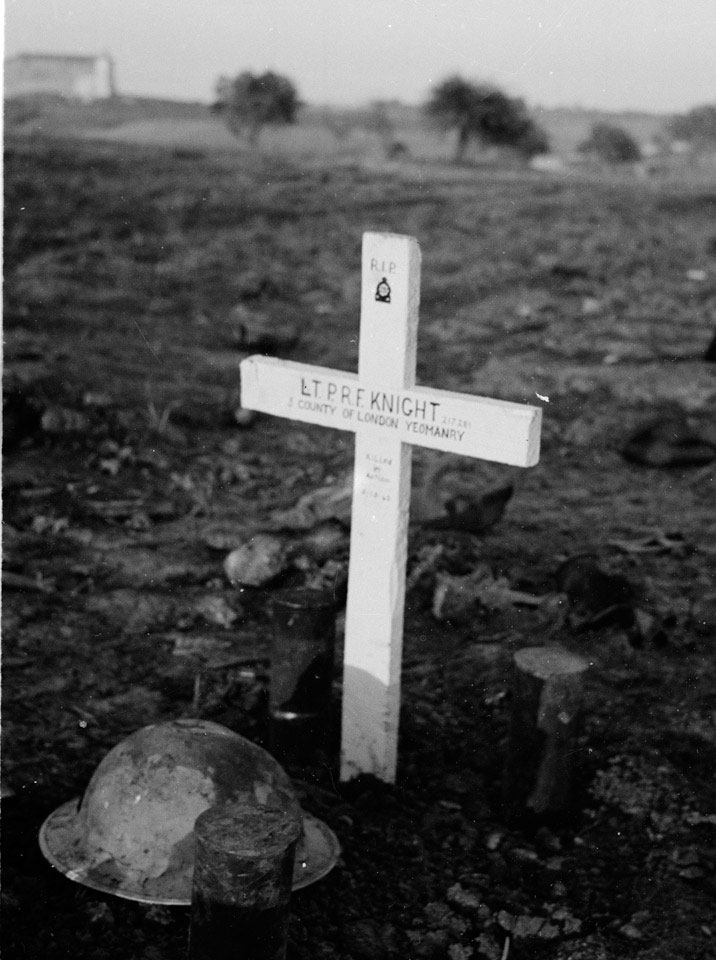
Online Collection
« Prev - 1 of 1 results - Next »
The grave of Lieutenant Peter Knight, 3rd County of London Yeomanry (Sharpshooters), Italy, 1943
Photograph by Major Wilfred Herbert James Sale, MC, 3rd/4th County of London Yeomanry (Sharpshooters), World War Two, Italy, 1943.
A British helmet lies next to a white wooden grave marker recording the death in action of 22 year old Lieutenant Peter Knight of the 3rd County of London Yeomanry. The cross has the correct service number but the initials appear to be incorrect.
The 3rd County of London Yeomanry War Diary for 1943 records Lieutenant P P R Knight among a group of '1st line reinforcements' that joined the Sharpshooters on 9 January 1943. In August 1943 he is reported as leading 'Knightforce', a combined force of Royal Engineers and Commandos in an amphibious operation in Sicily. Knight is finally mentioned amongst several men killed and wounded on mainland Italy, after heavy fighting with German tanks near Termoli on 5 October 1943.
The Commonwealth War Graves Commission records the grave of Lieutenant Peter Paul Robert Knight at the Sangro River War Cemetery in Italy.
Following the Allied invasion of Italy the Germans had set up a series of defensive lines across the country. The Volturno Line was the southernmost of these and included the RIver Biferno. The Biferno flows west to east into the Adriatic Sea just south of the town of Termoli. Control of the small but strategically valuable port of Termoli became the objective for both sides in October 1943.
Operation DEVON involved a force of commandos and other special forces landing from the sea. It successfully secured the port on the night of 2/3 October 1943, allowing Allied infantry units to ford the Biferno River and secure a bridgehead while engineers attempted to repair or replace bridges that the Germans had destroyed or damaged as they retreated.
The Allied position around Termoli quickly became isolated as flooding made the Biferno crossing hazardous, leaving the defenders desperately short of armour as the German 16th Panzer Division counterattacked.
On the night of the 4 October as Royal Engineers attempted to repair the main road bridge across the Biferno, a number of 'C' Squadron, 3rd County of London Yeomanry (Sharpshooters) tanks, commanded by Major Bobby Gale, successfully forded the river but the weight of the Sherman tanks soon made the ford unusable and at least one tank foundered in mid-stream.
As the isolated Allied forces in Termoli desperately tried to hold on to the town and the high ground which overlooked the river crossing, 'C' Squadron's tanks went into action defending the main road into the town. The Allies held out and the key bridge over the Biferno was repaired with sections of Bailey Bridge. This allowed Allied reinforcements, including the rest of the Sharpshooters to enter the battle on the afternoon of 5 October. The following day saw more Allied reinforcements arriving and the Germans were forced to retreat.
From an album containing 242 photographs compiled by Major W H J Sale, MC, 3rd/4th County of London Yeomanry (Sharpshooters).
NAM Accession Number
NAM. 1975-03-63-15-39
Copyright/Ownership
National Army Museum Copyright
Location
National Army Museum, Study collection
Object URL
https://collection.nam.ac.uk/detail.php?acc=1975-03-63-15-39

